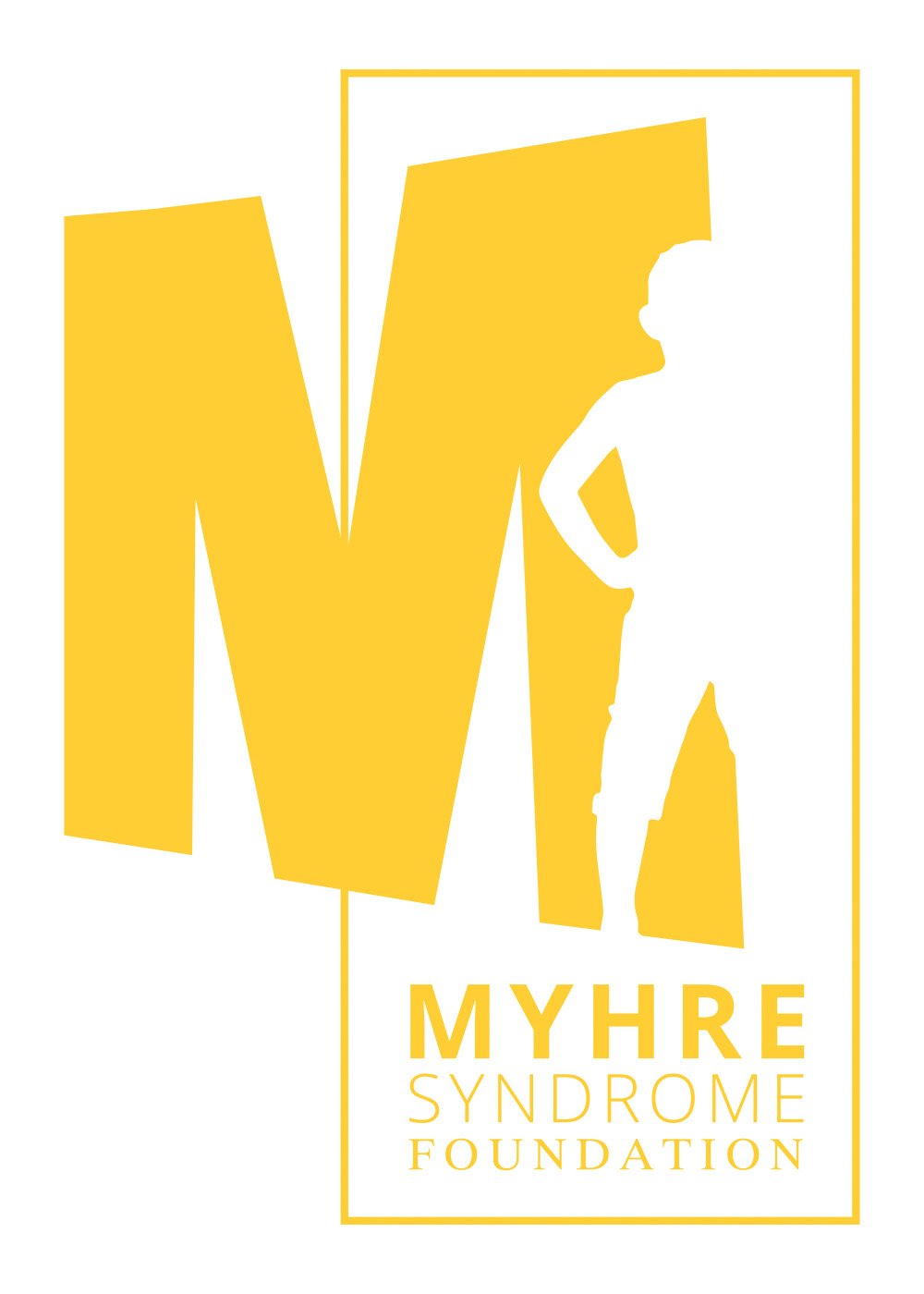General Reference
A one page summary on Myhre Syndrome from the Myhre Syndrome Foundation.
A natural history study of 12 patients, detailing progression of Myhre syndrome symptoms.
Overview from Genetics Home Reference/MedlinePlus
Abstract - Myhre syndrome is a connective tissue disorder with multisystem involvement, progressive and proliferative fibrosis that may occur spontaneously or following trauma or surgery, mild-to-moderate intellectual disability, and in some instances, autistic-like behaviors. Organ systems primarily involved include: cardiovascular (congenital heart defects, long- and short-segment stenosis of the aorta and peripheral arteries, pericardial effusion, constrictive pericarditis, restrictive cardiomyopathy, and hypertension); respiratory (choanal stenosis, laryngotracheal narrowing, obstructive airway disease, or restrictive pulmonary disease), gastrointestinal (pyloric stenosis, duodenal strictures, severe constipation); and skin (thickened particularly on the hands and extensor surfaces). Additional findings include distinctive craniofacial features and skeletal involvement (intrauterine growth restriction, short stature, limited joint range of motion). To date, 55 individuals with molecularly confirmed Myhre syndrome have been reported.
GeneReviews Myhre Syndrome
Lois J Starr, MD, Noralane M Lindor, MD, and Angela E Lin, MD. First published: 13 April 2017
Abstract - Myhre syndrome (MS) is a developmental disorder characterized by typical facial dysmorphism, thickened skin, joint limitation and muscular pseudohypertrophy. Other features include brachydactyly, short stature, intellectual deficiency with behavioral problems and deafness. We identified SMAD4 as the gene responsible for MS. The identification of SMAD4 mutations in Laryngotracheal stenosis, Arthropathy, Prognathism and Short stature (LAPS) cases supports that LAPS and MS are a unique entity. The long‐term follow up of patients shows that these conditions are progressive with life threatening complications. All mutations are de novo and changing in the majority of cases Ile500, located in the MH2 domain involved in transcriptional activation. We further showed an impairment of the transcriptional regulation via TGFβ target genes in patient fibroblasts. Finally, the absence of SMAD4 mutations in three MS cases may support genetic heterogeneity.
Myhre Syndrome
C. Le Goff, C. Michot, V. Cormier‐Daire
First published: 01 March 2014
Abstract - Myhre syndrome (MYHRS, OMIM 139210) is an autosomal dominant disorder characterized by developmental and growth delay, athletic muscular built, variable cognitive deficits, skeletal anomalies, stiffness of joints, distinctive facial gestalt and deafness. Recently, SMAD4 (OMIM 600993) was identified by exome sequencing as the disease gene mutated in MYHRS. Previously only three missense mutations affecting Ile500 (p.Ile500Thr, p.Ile500Val, and p.Ile500Met) have been described in 22 unrelated subjects with MYHRS or a clinically related phenotype. Here we report on a 15‐year‐old boy with typical MYHRS and a novel heterozygous SMAD4 missense mutation affecting residue Arg496. This finding provides further information about the distinctive SMAD4 mutation spectrum in MYHRS. In silico structural analyses exploring the impact of the Arg‐to‐Cys change at codon 496 suggested that conformational changes promoted by replacement of Arg496 impact the stability of the SMAD heterotrimer and/or proper SMAD4 ubiquitination.
Novel SMAD4 mutation causing Myhre Syndrome
Viviana Caputo, Gianfranco Bocchinfuso, Marco Castori, Alice Traversa, Antonio Pizzuti, Lorenzo Stella, Paola Grammatico, Marco Tartaglia
First published: 08 April 2014
Published by MassGeneral Hospital Myhre Syndrome Clinic - What You Need to Know About The Genetic Cause
Abstract - The work included in this dissertation is limited to my three most important first author published manuscripts since starting the Clinical Translational Research (CTR) Mentored Scholar’s Program through the University of Nebraska Medical Center. All are patient-inspired. During these past five years, I have also been involved with 16 additional manuscripts delineating the phenotype and care of rare disease. Two in this dissertation are devoted to Myhre syndrome.
Delineating Phenotypes of Rare Disease
Starr, Lois, J
(2019).Theses & Dissertations. 393.
Abstract - A new syndrome characterized by growth and mental deficiency, unusual facies, hearing loss, generalized muscular hypertrophy, joint limitations and skeletal deformities is described. Older paternal age has been documented in these two cases.
First citing of Myhre Syndrome
Myhre SA, Ruvalcaba RH, Graham CB:
A new growth deficiency syndrome.
First published July 1981
For Primary Care Providers
MassGeneral Hospital Myhre Syndrome Clinic patient resources
We appreciate the generosity of Wiley Publishing who have provided links to courtesy copies of their articles.
